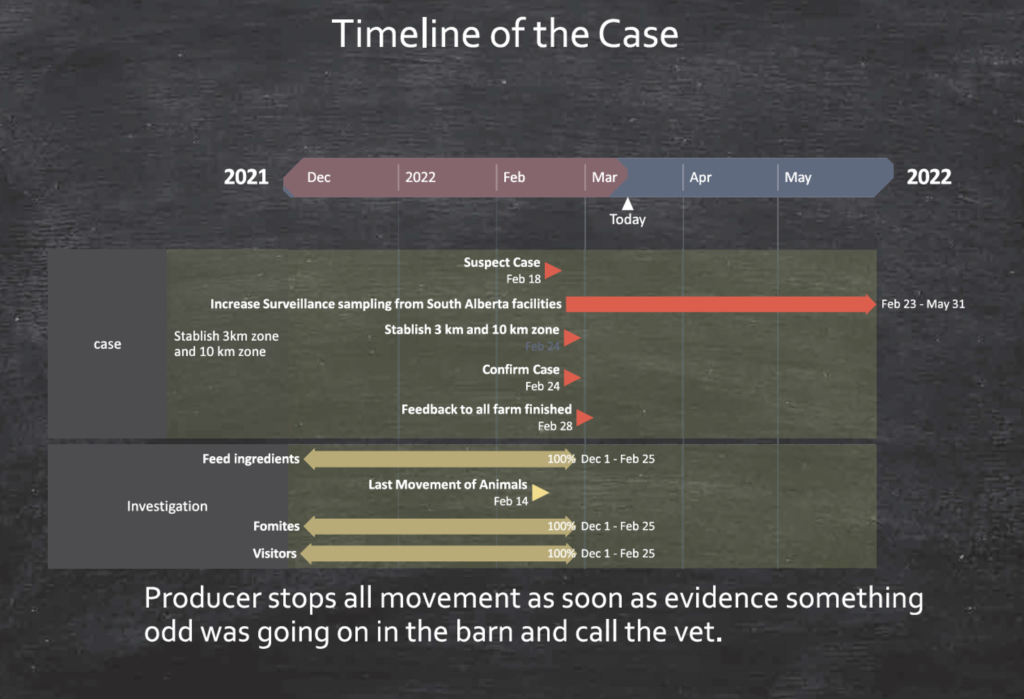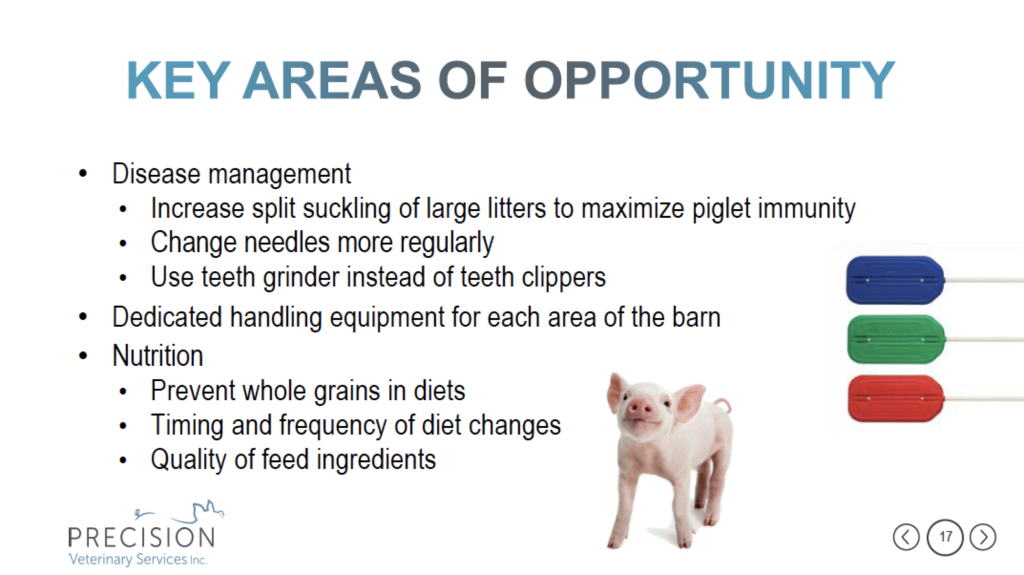Managing foreign animal disease is the priority in emergency planning at Alberta Pork, says the organization’s quality assurance and production manager.
Javier Bahamon delivered updates during AP’s regional meetings with producers in March, including the status of a porcine epidemic diarrhea outbreak confirmed on one farm earlier this year. Veterinarians Kurt Preugschas and Cordell Young of Precision Veterinary Services then described findings from an antimicrobial use (AMU) study performed on 20 farms from 2016 through 2020.
Bahamon said Alberta’s first incidents of PED had occurred during a short period of time in 2019, when outbreaks were confirmed on three Alberta farms. A new and isolated case was confirmed on Feb. 24, said Bahamon.
The last movement of animals from that farm had been recorded on Feb. 14.
The producer himself played a key role in managing a potential outbreak by stopping all animal movement in and out of his farm and calling his herd vet as soon as he suspected that something was amiss, said Bahamon.
“It can be nothing, it can be everything. In this case, it was the very right thing to do,” he said.
As soon as the vet reported the disease to authorities, protocols kicked into gear to contain a potential outbreak, including establishment of three-kilometer and 10-km biosecurity zones around the farm.

Efforts were made to clear the producer’s farm of virus, including an investigation to find the source and determine whether any other farms or facilities had been infected.
Sampling has ruled out all potential sources except porcine plasma, recycled feed totes and pallets. Traceback on those items was not possible, but any of the three could be the actual source of the infection, said Bahamon.
Disease surveillance was ramped up on all swine handling facilities, including processing plants, truck washes and assembly yards, with positive samples found in the time frame starting Dec. 1, 2021 and moving through to March 10, 2022.
During that time frame, 678 samples were taken at those facilities and no positive results were found.
Containment protocols continue on farm with no further reports of any sick animals on the farm. Moving forward, the manure management plan is being reviewed and the team continues to work with the abattoir regarding pre-slaughter testing protocols. Work is also being done to map haul routes that pass the lowest possible number of swine farms and to find a truck wash location that would be most suitable for handling trucks servicing the farm, said Bahamon.
“We need to be really careful with how we interpret results,” he said.
The tests can confirm DNA from the virus but cannot show if that specific sample can cause the disease. Companies that sold product to the affected farm have been working closely with the response team in its investigation, said Bahamon.
A producer attending the meeting said he and some others have stopped using blood plasma and he is calling on other producers to stop using it as well, stating that it is not worth the risk to the industry in Alberta.
Bahamon assured producers that they will be the first to receive information if any positive samples are found and that, as of the March 16 meeting, no further positives had been found. Suppliers involved in the investigation will also be kept in the loop so they can take appropriate measures if positive samples are found.

Bahamon went on to introduce the Precision Veterinary study, which Preugschas presented for the Red Deer meeting.
He and Young had collected data over a span of five years to determine the effects of antimicrobial management on a variety of farrow-to-finish farms. After working through the methodology and raw figures, Preugschas said the team then look at the five farms that were using the highest levels of antimicrobials and compared them with the farms that were using the least.
Their goals were to help identify any internal biosecurity opportunities on farms that could help reduce the need for antimicrobials and to see if there were any specific internal biosecurity practices that the low AMU farms were doing versus the high AMU farms.
They found key opportunities to improve herd health and reduce AMU costs through a variety of management practices, including hygiene; barn flow and room management; disease management; dedicating handling equipment to each room, and nutrition. Within those practices, he mentioned avoiding whole grain and ensuring ventilation systems are working correctly as areas where good management would improve animal health.
Key findings in comparing the highest AMU farms to the lowest were that the lower-usage farms had higher levels of all-in, all-out animal flow; pigs that had been moved to sick pens were not put back; there was strict hygiene protocols, more regular cleaning of handling equipment and more effort spent on washing, degreasing and disinfecting pens, hallways and walkways between groups.
Averaged over the five years of the study and calculated in 2022 dollars, they found that low AMU farms spent $171.69 less per sow than highest-use farms. On a 400-sow farm, that’s a difference of $68,677.60 a year, said Preugschas. That may be small potatoes compared to feed costs, but it’s still a lot of money, he said.
Their ultimate recommendation to producers is to “use as little as possible, but as much as necessary” in treating and protecting their animals.
The writing is on the wall if producers wish to retain access to antimicrobials, said Preugschas.
“If we don’t prove to the world that we are looking after things, we will lose those tools. I will not be able to write a prescription for plasma antibiotics. I want to show that we’re doing the right things and not have to have governments telling us what to do,” he said.
Alberta Pork regional meetings are held in early spring at various sites throughout the province to give producers an update on important developments within their industry and to hear from producers who may have ideas or concerns that they would like to share with the board and staff.
Chair Brent Moen thanked director Hendrik Fourie, whose term has expired after six years. He welcomed new directors Dan Majeau and Stan Vanessen, who were acclaimed in the two vacant positions.
Please visit the Alberta Pork website at www.albertapork.com for brief biographies and contact information for all directors and staff. Helpful information including feed cost analysis and animal health tools are available within the producers’ section of the website. •
— By Brenda Kossowan




